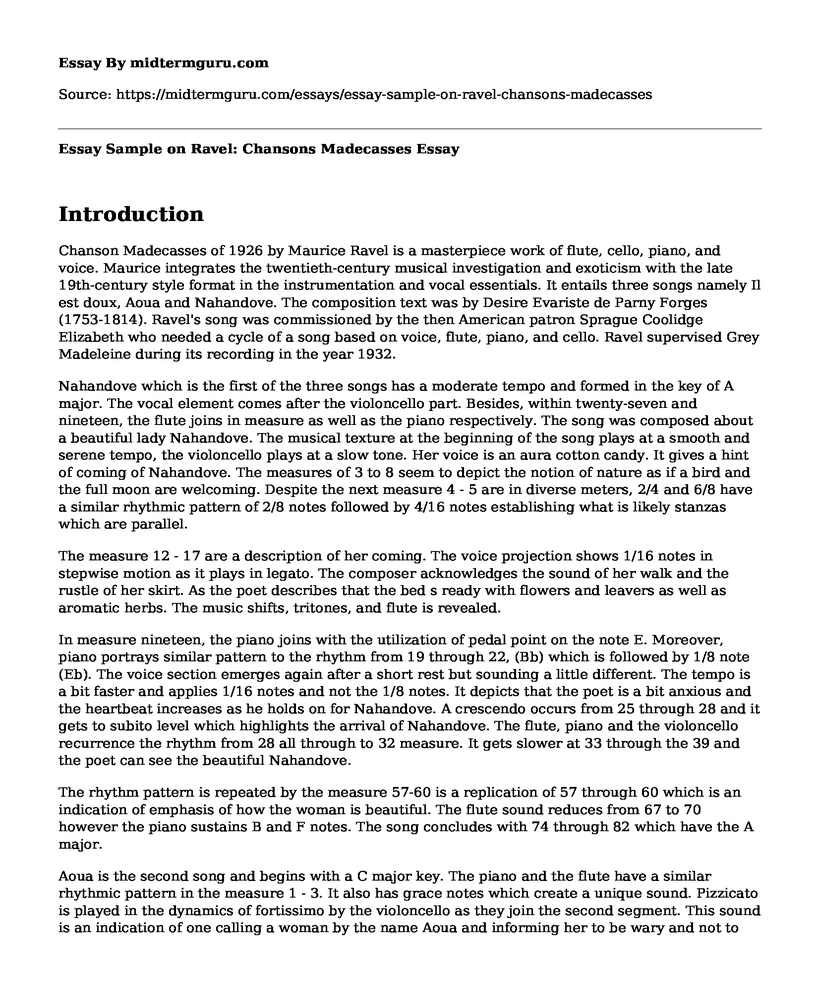Introduction
Chanson Madecasses of 1926 by Maurice Ravel is a masterpiece work of flute, cello, piano, and voice. Maurice integrates the twentieth-century musical investigation and exoticism with the late 19th-century style format in the instrumentation and vocal essentials. It entails three songs namely Il est doux, Aoua and Nahandove. The composition text was by Desire Evariste de Parny Forges (1753-1814). Ravel's song was commissioned by the then American patron Sprague Coolidge Elizabeth who needed a cycle of a song based on voice, flute, piano, and cello. Ravel supervised Grey Madeleine during its recording in the year 1932.
Nahandove which is the first of the three songs has a moderate tempo and formed in the key of A major. The vocal element comes after the violoncello part. Besides, within twenty-seven and nineteen, the flute joins in measure as well as the piano respectively. The song was composed about a beautiful lady Nahandove. The musical texture at the beginning of the song plays at a smooth and serene tempo, the violoncello plays at a slow tone. Her voice is an aura cotton candy. It gives a hint of coming of Nahandove. The measures of 3 to 8 seem to depict the notion of nature as if a bird and the full moon are welcoming. Despite the next measure 4 - 5 are in diverse meters, 2/4 and 6/8 have a similar rhythmic pattern of 2/8 notes followed by 4/16 notes establishing what is likely stanzas which are parallel.
The measure 12 - 17 are a description of her coming. The voice projection shows 1/16 notes in stepwise motion as it plays in legato. The composer acknowledges the sound of her walk and the rustle of her skirt. As the poet describes that the bed s ready with flowers and leavers as well as aromatic herbs. The music shifts, tritones, and flute is revealed.
In measure nineteen, the piano joins with the utilization of pedal point on the note E. Moreover, piano portrays similar pattern to the rhythm from 19 through 22, (Bb) which is followed by 1/8 note (Eb). The voice section emerges again after a short rest but sounding a little different. The tempo is a bit faster and applies 1/16 notes and not the 1/8 notes. It depicts that the poet is a bit anxious and the heartbeat increases as he holds on for Nahandove. A crescendo occurs from 25 through 28 and it gets to subito level which highlights the arrival of Nahandove. The flute, piano and the violoncello recurrence the rhythm from 28 all through to 32 measure. It gets slower at 33 through the 39 and the poet can see the beautiful Nahandove.
The rhythm pattern is repeated by the measure 57-60 is a replication of 57 through 60 which is an indication of emphasis of how the woman is beautiful. The flute sound reduces from 67 to 70 however the piano sustains B and F notes. The song concludes with 74 through 82 which have the A major.
Aoua is the second song and begins with a C major key. The piano and the flute have a similar rhythmic pattern in the measure 1 - 3. It also has grace notes which create a unique sound. Pizzicato is played in the dynamics of fortissimo by the violoncello as they join the second segment. This sound is an indication of one calling a woman by the name Aoua and informing her to be wary and not to trust white men. In the measure six, the poet shifts to F# from C major. The pedal point of F#-G is present in the measure of 6-18. Flute and piano are in legato through to 18. Onwards to 29 flutes is silent but the piano compliments the poet.
An octave A indicates the segment where the pedal point occurs for the piano at 19 and 24. The writer extensively indicates the narration of the white men with the notes E and B. flute gets clear again at 30 through 37 and the violoncello also in the rhythmic and even gets a crescendo at 32nd notes. 38 to 61 rises in a grace note which portray people's worry of another dictator.
In the third song, Il est doux starts with a flute with the utilization of triplets in legato. The major key is Db with a slow tempo. In a vocal smooth tone, the violoncello unites the theme of the sound with natural harmonic tone (). 7-8 the piano joins and then singer sings in after instrumentals hit the waves one after the other. In triplets of 10-15, the piano plays establishing a relaxing sound. The piano section in measure 15 seems to display the same rhythm as in the measure 7. It is a segment with presumably introduces an individual who is spending good time under a tree. A shift from 2/4 to 4/4 is experienced at 18 as the violoncello joins in measure twenty and the individual might take a sleep under the tree. The song presents a tranquil sound and highlights the life of someone in one afternoon. Grey's recording is quite melodious and seems more detailed than the rest.
Cite this page
Essay Sample on Ravel: Chansons Madecasses. (2022, Nov 02). Retrieved from https://midtermguru.com/essays/essay-sample-on-ravel-chansons-madecasses
If you are the original author of this essay and no longer wish to have it published on the midtermguru.com website, please click below to request its removal:
- Movies Analysis Essay on Bicycle Thief, Witness to Murder and Potemkin
- Nike: A Sports Giant - From Track & Field to World's Largest Retailer - Essay Sample
- Pandora Exploration - Essay Sample
- A Great Day in Harlem: Art Kane's Iconic Jazz Photo - Essay Sample
- Movie Analysis Essay on Zoot Suit
- Movie Analysis Essay on Taxi Driver
- Shea Diamond: Trans Soul Singer and Songwriter's Inspiring Journey - Essay Sample







